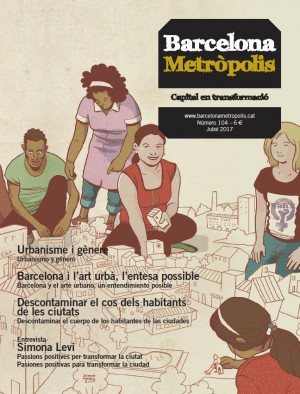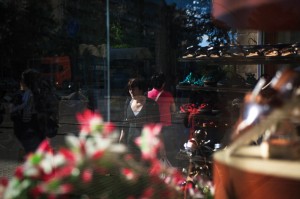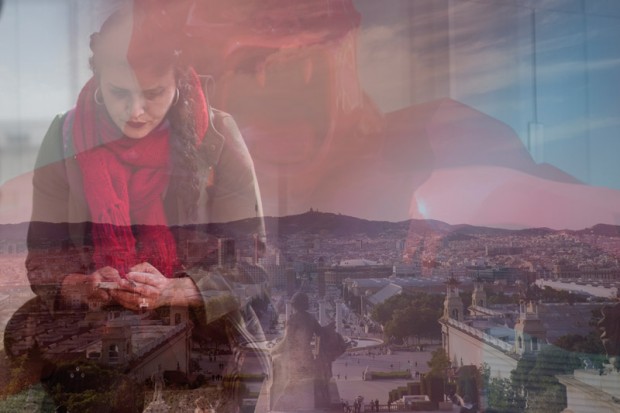
Barcelona City Council plans to redesign the city with a view to raising the profile of everyday activities, rather than production-focused activities. The Council’s Gender Mainstreaming Department suggests that the city is currently “built on the male breadwinner model”.
Photo: Arianna Giménez
Efforts to refocus urban planning to take into account the human aspect place a special emphasis on the gender perspective, the aim being to obtain an equal use of the city based on the diversity of gender, ethnic origin, age or occupation of the community.
Carrer de la Princesa was opened in November 1853, the same year that Barcelona City Council sent Madrid its plans to knock down the city walls, which began to take effect the following year. Nineteen centuries after Barcino was first founded, the city was preparing for its biggest urban transformation yet: expansion towards the Llobregat and Besòs rivers. The construction of Carrer de la Princesa saw dozens of houses demolished and many mediaeval lanes disappeared, but to leaders of the time it was worth the effort: opening the road would provide a straighter, more direct and wider route for military carriages to easily cover the 750 metres separating the citadel, or Ciutadella, from Plaça Sant Jaume.
and setting up barricades in the narrow streets, which was much easier than at the junction of Gran Via and Passeig de Gràcia, for example. The result is a city where one can drive to work, a city that has grown in parallel with the consolidation of the capitalist system and that defines itself by its public face — the world of the working man, the public man, the breadwinner — and its private face — the housewife, ‘her indoors’, who does not see a penny for her hard work.
Cities are not neutral; Barcelona is no exception. Sonia Ruiz, head of Barcelona City Council’s Department of Gender Mainstreaming, says that an urban model that meets the needs and experiences of everyday life is needed: “The city is built on the male breadwinner model; it is not planned for any other uses that are not solely based on the formal labour market, namely public services, shops, schools and primary care centres, among others.”
In order to take into account other needs and experiences that are essential when building neighbourhood communities, Barcelona City Council is proposing to redesign the city to give more visibility to the diverse range of activities, uses and tasks that people do each and every day, thereby shifting the focus of urban planning in the city away from a productive-centric emphasis and towards a more humanistic focus. These ambitious objectives therefore require a transversal approach — rather than just from an urban planning perspective — to ensure that these changes are successful. After a brief conversation with Sonia Ruiz, this necessity becomes clear: “Before implementing any measures, we need to put our house in order.” In December 2015 (six months into its mandate), the city’s new administration presented its gender mainstreaming measures, which are aimed at “integrating the gender perspective into all areas of public policy”, says Ruiz. To do so requires a process of institutional change that involves reviewing processes and routines in order to integrate equality as a prerequisite, train council staff and hire specialists in feminism.
Urban planning with a gender dimension
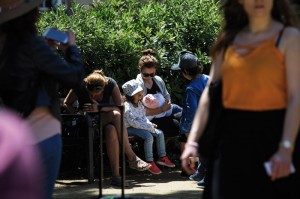
Women more urgently need an accessible city because they are the ones who travel around it the most, often lugging shopping carts or pushing prams.
Photo: Arianna Giménez
The Ecology, Urban Planning and Mobility Area has been the most involved in the government’s policy on “Urban planning with a gender dimension” (with the telling subtitle “Urban planning for everyday life”), presented on 22 March. The plan not only aims to tackle issues relating to women, but also aims to give the city back for the people to use, from an equality perspective, taking into account issues of gender, ethnic origin and age diversity as well as the functional needs of the neighbourhood. It is a perspective that, for the mere fact of being based on equality, is based on feminism: “It’s true that we are taking women more into account, since they have historically been excluded, but the policy is not aimed solely at women; rather, its objective is to place the everyday lives of people at the centre, with a clear gender perspective”, says Mercè Llopis, Technical Coordinator of the City Council’s Department of Urban Modelling (part of the Urban Ecology Agency).
Men and women do not use the city in the same way. The Plan for Gender Justice, published in July 2016, specifically states that there is a “strong gender bias in terms of the uses and the freedoms and associated rights” in the city. Moreover, the Plan reveals that women are more likely to use local shops, primary health centres, schools, day-care centres and children’s play areas than are men, who more often use sports, leisure and recreation facilitates. It is an overexposed snapshot of traditional roles: the woman looks after the family, the man is the breadwinner who enjoys his leisure time.
The Working Day Mobility Survey, carried out in 2014 by the Metropolitan Transport Authority in conjunction with the City Council and the Regional Government, also demonstrates gender-specific uses. According to the survey, women move around the city primarily for family reasons, with occupational reasons in second place (15.6%), while men’s motivation for moving about is generally to do with work (19.4%). Women make more journeys, more often and, above all, more locally. Moreover, women make more use of public transport and walk more; men, on the other hand, use private transport more often: 32.3% of men use a car compared to 25.4% of women. On that basis, women are the ones who most need an accessible city because they are the ones who travel around it the most, often lugging a shopping trolley or pushing their children in a pram.
With that in mind, Sonia Ruiz, of the Council’s Department for Gender Mainstreaming, says that a two-pronged strategy was required: “Some actions are aimed at preventing discrimination against women while others are intended to equalise men’s and women’s participation. Positive measures are being implemented in spaces where women do not often go, and in other spaces to encourage more men to go, such as nursery schools.
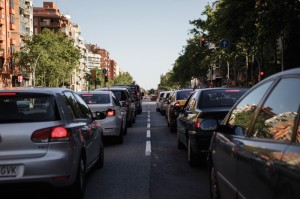
Men, who move around more for occupational reasons, use private transport more often than do women: 32.3% of men use a car to get around compared to 25.4% of women, according to the Working Day Mobility Survey carried out in 2014 in the Metropolitan Area.
Photo: Arianna Giménez
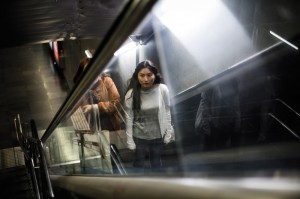
People’s mobility patterns change depending on the care burden they face, a burden that is particularly significant in the case of women. Many of the urban development actions that are planned will take this approach.
Photo: Arianna Giménez
One of the activities planned from a gender perspective is a multi-approach project for Avinguda Meridiana, aimed, according to Llopis, at turning it into a much friendlier avenue, creating more walkable pavements and reducing the number of cars. The objective is to make it easier to cross from one side to the other, a journey most often made by local residents: “We are trying to make it so that the street crossings are more convenient, so that people living near the Meridiana can easily get across to do their shopping, go to school or do any activity they want. The idea is to stop Avinguda Meridiana being thought of as a difficult river to cross”, she says.
Against the feminisation of poverty
Breaking the narrative of gender separation in areas of the city means tackling the root causes of the feminisation of poverty, a structural impediment to achieving more equal conditions. Some 28% of Barcelona’s residents are at risk or in a situation of exclusion; of that figure, 55% are women. According to Barcelona’s Gender Justice Plan, “the average take-home pay for women is 18% lower than that of men”. What is more, since women bear disproportionate responsibility for providing care and doing unpaid housework, it is more difficult for women in Barcelona to lift themselves out of poverty. “Gentrification also more adversely affects non-white women, older women, poor women, large families, single-parent families and immigrant women, among others”, according to the government’s Urban Planning and Gender policy.
Without doubt, the most common areas of inequality (age, ethnic origin, class, gender identity or sexual orientation) cause the most obvious situations of poverty. “In addition, the lack of a work permit or qualifications, and transsexuality, exclude women from the formal labour market”, according to the Strategy to combat the feminisation of poverty and vulnerability, published in July 2016. This plan, which has the long-term objective of halving the number of women living in poverty in Barcelona, examines the socioeconomic realities disaggregated by gender: “As a result of intermittent career paths or working as homemakers, older women receive 38% less in contributory pensions than men, and single-parent families headed by women run a very high risk of poverty (40%).”
Austerity policies and the erosion of rights brought about by labour and pension reforms, along with the revision to article 135 of the Constitution and the decision to bail out the banks using public money, have caused budget cuts in public services and for employees that disproportionately affect women because they have more need of them.
This inequality in wealth distribution has been exacerbated by the decline in public spending for health-care services — as a result of the freeze to Law 39/2006 on personal autonomy — and the reduction in public nursery school places. Against that background, and without losing sight of the urban focus, the City Council is working to democratise and nationalise care: it cannot be left to families and, in particular the female members of those families, to provide; men must take on more responsibility, as must the government. Or, at the very least, it should try to change the city landscape so that it is friendlier and more inclusive for carers.
In that vein, the Department for Life Span, Feminism and LGBTI drafted a policy aimed at democratising care services, which it submitted at the end of May. Marta Cruells, the department’s political advisor on gender equality, says that the policy was a year and a half in the making and was based on consultations with carers and persons being cared for, public and private care providers, shared parenting groups and organisations providing care for the elderly, among others.
The policy’s objective is to recognise and place a value on care, taking into account that from birth to death “everyone needs to be looked after and, in all likelihood, we will all have to look after someone else”, Marta Cruells. A clear way of socially acknowledging this activity is to factor it into the budget. “Care services account for 25% of a society’s gross domestic product”, she adds. That is a lot of money for an activity that so often goes unpaid.
The policy incorporates more than seventy activities, the first of which is to map all the programmes and services offered by the City Council in relation to the provision of care. Many of the activities have been formulated with care services in mind, since, as Marta Cruells explains, mobility patterns change depending on the level of care with which a person is provided: “Another way of looking at the city is from the point of view of daily life”. One of the specific measures is to build five new family facilities and increase the number of nursery schools.
Safety and prevention from a gender perspective
Structural changes in terms of mainstreaming, combating vulnerability and ensuring mobility and care services, will never be successful if the issue of violence against women is not stopped once and for all. In 2013, the City Council’s Prevention and Safety Area conducted a gender and safety audit in order to mainstream the gender perspective in data collection on safety issues and in the implementation of public policies on safety and prevention in Barcelona. Following the audit, municipal technical staff were trained in safety audit methodologies from a gender perspective. These audits served as a starting point for identifying the spaces where there is a perception of insecurity and launching activities to improve the public space and put an end to these urban incidents of violence against women.
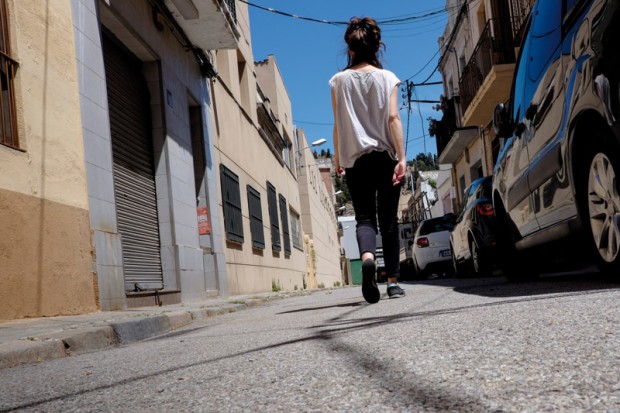
The neighbourhood plan provides for women’s reconnaissance walks in all districts with a view to identifying the factors that create insecurity.
Photo: Arianna Giménez
Sonia Ruiz, head of the City Council’s Gender Mainstreaming Department, says of the only safety audit that has been undertaken during the current mandate, on 24 November 2016, at Colònia Santiveri in the Mare de Déu del Port neighbourhood, within the Zona Franca area of Barcelona: “The participants — around twenty or so local residents, technical personnel and activists, among others — made some very reasonable requests, such as improving lighting and stairways, pruning trees and cleaning up the area.” The most dangerous areas tend to be dark spaces or those with lots of vegetation; women are more vulnerable there since they cannot see well or be seen. “For that reason, we are attempting to ensure that the safety audits are used to inform those tasked with carrying out improvements; for example, the city police and park and garden rangers.”
The Council’s Neighbourhood Plan provides for at least one of these audits to be carried out in each neighbourhood. “The aim is to do ten more audits over the next two years,” says Ruiz. One audit is likely to be conducted on Carrer de Pi i Margall as part of its remodelling plan. Mercè Llopis, from the Council’s Urban Ecology Area, says that a participatory process has been initiated with local residents, businesses and, in particular, the women’s committees of the two districts affected: Gràcia and Horta-Guinardó. There is a danger, however, that this participation does not take the gender perspective into account: “Depending on the time the meeting takes place, and if we fail to use ways to encourage women to take part (for example, providing a waiting area with female staff to look after children), more men than women will attend,” argues Ruiz. “When asked about if and how a road should be renovated, what is likely is that men will say that they need more car parking spaces.”
Some 29.9% of women in Barcelona have at some point in their lives been victims of serious gender-based violence; 16.3% have been attacked on the street and 29% ensure that they never leave the house alone; and yet, only 0.4% of female victims have filed a police complaint. This data come from the Gender-Based Violence Survey published in 2011, which contains shocking data that reveal a number of self-defence strategies used almost exclusively by women (for example, more than 9% of women carry some kind of object for self-defence, such as a spray), often based on limiting their exposure to risk in public spaces by restricting their freedom of movement and personal autonomy.
Predating the institutionalised measures, social and feminist movements in the Poble-Sec neighbourhood established a protocol of action to combat gender-based violence, which was implemented during the street festivals of 2015 and was awarded the 25 November Prize (International Day for the Elimination of Violence against Women) by the Council. Since that experience, work has been under way throughout 2016 to implement similar protocols in the remaining districts, albeit tailored to the characteristics of each street festival. As Marta Cruells explains: “The Council has requested that all protocols share certain minimum elements, such as the provision of basic training for all persons responsible for organising each festival. Organising a large festival like the Gràcia festival is not the same as organising, say, the Nou Barris festival, which is much smaller and has virtually no concerts.”
Another approach was taken during the La Mercè festivals in 2016. A stand was set up in Avinguda de la Reina Maria Cristina, which was the site of concerts that attracted a younger crowd. Two people staffed the stand and two others patrolled the concert area. “If they saw anything or if someone made a complaint to them, they were able to take immediate action. And they did so on a couple of occasions. They also directed victims to the stand to make a complaint and seek help. Around a dozen such cases were reported”, says Cruells.
The same model was also implemented at the Lali Jove festival on 12 February and a stand was installed on a permanent basis at the Vila Olímpica, a busy area for nightlife, full of bars and nightclubs and popular with foreign tourists spending a few days in Barcelona and university students on their Erasmus year abroad. “The Mossos d’Esquadra (the Catalan regional police force) have detected a rise in complaints of sexual violence in this part of the city”, says Cruells.
One of the activities implemented at the Poble-Sec festival was that, if any violence against women occurred in the concert areas, the music was stopped and a message emitted over the PA system to inform the audience of what had happened. Stopping Barcelona’s urban planning model and restarting it from a different perspective will only be possible with the important work of public action groups and the political awareness of a council that integrates a gender perspective.



